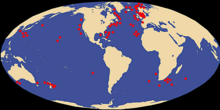
Back Architeuthis dux AST Гигантски калмар Bulgarian Architeuthis dux Breton Architeuthis dux Catalan Architeuthis dux CEB Architeuthis dux Spanish Architeuthis dux Estonian Óriáskalmár Hungarian Architeuthis dux Italian 대왕오징어 Korean
| Giant squid | |
|---|---|

| |
| Giant squid, Architeuthis sp., modified from an illustration by A. E. Verrill, 1880 | |
| Scientific classification | |
| Domain: | Eukaryota |
| Kingdom: | Animalia |
| Phylum: | Mollusca |
| Class: | Cephalopoda |
| Order: | Oegopsida |
| Superfamily: | Architeuthoidea |
| Family: | Architeuthidae Pfeffer, 1900 |
| Genus: | Architeuthis Steenstrup in Harting, 1860 |
| Species: | A. dux
|
| Binomial name | |
| Architeuthis dux Steenstrup, 1857
| |

| |
| Worldwide giant squid distribution based on recovered specimens | |
| Synonyms | |
| |
The giant squid (Architeuthis dux) is a species of deep-ocean dwelling squid in the family Architeuthidae. It can grow to a tremendous size, offering an example of abyssal gigantism: recent estimates put the maximum size at around 12–13 m (39–43 ft)[2][3][4][5] for females and 10 m (33 ft)[3] for males, from the posterior fins to the tip of the two long tentacles. This makes it longer than the colossal squid at an estimated 9–10 m (30–33 ft),[6] but substantially lighter, as the tentacles make up most of the length.[7] The mantle of the giant squid is about 2 m (6 ft 7 in) long (more for females, less for males), and the length of the squid excluding its tentacles (but including head and arms) rarely exceeds 5 m (16 ft).[3] Claims of specimens measuring 20 m (66 ft) or more have not been scientifically documented.[3]
The number of different giant squid species has been debated, but genetic research suggests that only one species exists.[8]
In 2004, a Japanese research team obtained the first images of a living animal in its habitat.[9]
- ^ Allcock, L.; Barratt, I. (2014). "Architeuthis dux". IUCN Red List of Threatened Species. 2014: e.T163265A991505. doi:10.2305/IUCN.UK.2014-1.RLTS.T163265A991505.en. Retrieved 19 November 2021.
- ^ Cite error: The named reference
McClain_etal_2015was invoked but never defined (see the help page). - ^ a b c d Cite error: The named reference
OSheawas invoked but never defined (see the help page). - ^ Tracey, D. M., O. F. Anderson & J. R. Naylor (2011). A guide to common deepsea invertebrates in New Zealand waters. Third edition. Archived 23 February 2021 at the Wayback Machine National Institute of Water and Atmospheric Research, Wellington. 317 pp.
- ^ Yukhov, V. L. (2014). Гигантские кальмары рода Architeuthis в Южном океане / Giant calmaries Architeuthis in the Southern ocean Archived 9 March 2024 at the Wayback Machine. [Gigantskiye kalmary roda Architeuthis v Yuzhnom okeane.] Ukrainian Antarctic Journal no. 13: 242–253. (in Russian)
- ^ Roper, C. F. E.; Jereb, P. (2010). "Myopsid and Oegopsid Squids". In Jereb, P.; Roper, C. F. E. (eds.). Cephalopods of the world. An annotated and illustrated catalogue of species known to date. FAO Species Catalogue for Fishery Purposes. Vol. 2. Rome: FAO. pp. 148–178. No. 4, Vol. 2. Archived from the original on 29 January 2019. Retrieved 9 September 2013.
- ^ Atkinson, Kent (1 May 2008). "Size matters on 'squid row' (+photos, video)". The New Zealand Herald. Retrieved 25 September 2011.
- ^ Cite error: The named reference
geneticswas invoked but never defined (see the help page). - ^ Kubodera, T.; Mori, K. (2005). "First-ever observations of a live giant squid in the wild". Proceedings of the Royal Society B: Biological Sciences. 272 (1581): 2583–2586. doi:10.1098/rspb.2005.3158. PMC 1559985. PMID 16321779.
